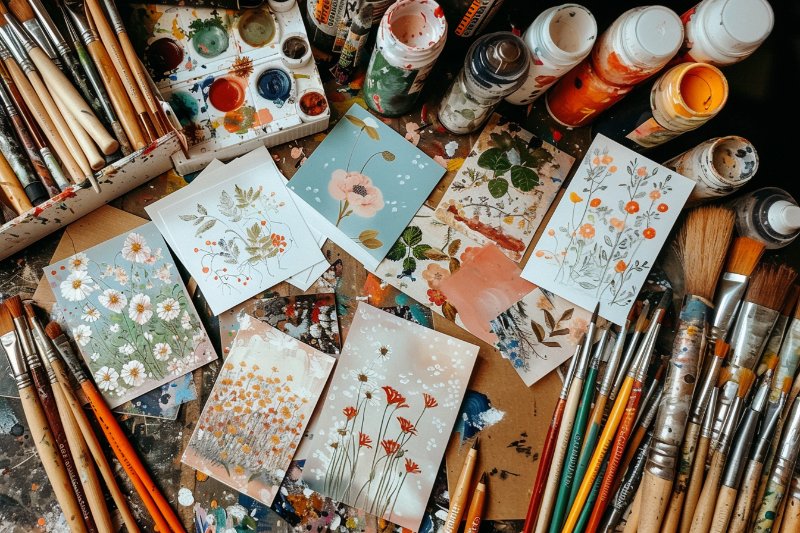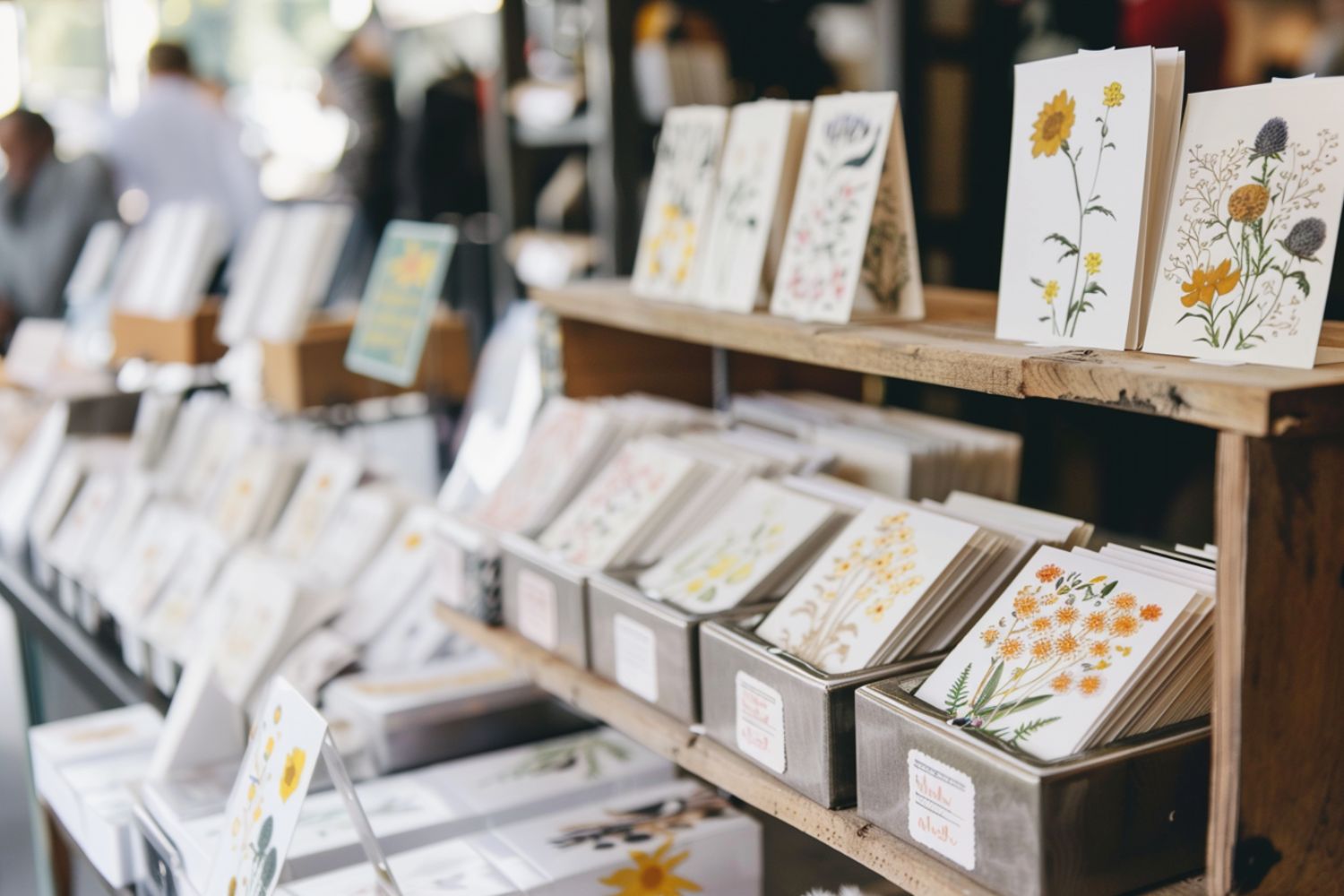Transforming your artistic endeavours into greeting cards is not merely about transferring images onto paper. It’s an intimate process of sharing your art with the world, allowing your creativity to become part of people’s celebrations and sentiments. This comprehensive guide aims to navigate you through the nuances of monetising your art through greeting cards, from conceptualisation to reaching the shelves of customers, including tips on contacting existing distributors and established greeting card companies.
Table of Contents
The Art of Transformation: From Canvas to Card
- Conceptualise Your Theme: Begin by deciding the themes your artwork will cover. Seasonal festivities, birthdays, anniversaries, and everyday moments are popular themes. Consider what emotions or messages your art conveys and how they can fit into these contexts.
- Adapt Your Art for Greeting Cards: Not all artworks translate well into a greeting card format. Consider the composition and how it fits into a typical card size. You might need to resize or crop your artwork or create new pieces specifically for this purpose.
- Quality Matters: Ensure that your artwork is reproduced with the highest quality. This might involve investing in professional scanning or photography to capture the detail and colours of your original pieces accurately.
the journey of transforming your artwork from canvas to card is not just about resizing an image; it’s about reimagining your art within the intimate confines of a greeting card, a piece that holds the potential to convey emotions and connect individuals across distances and time. This transformation process is both an art and a science, requiring a thoughtful approach to conceptualisation, adaptation, and quality assurance.
Conceptualising Your Theme
The initial step in this transformative journey is to conceptualise the theme of your artwork. This is a pivotal phase where you delve deep into the essence of your art and contemplate the myriad of themes it could encapsulate. Seasonal festivities, such as the warmth of Christmas, the vibrancy of Easter, or the reflective nature of New Year’s, offer a canvas for your creativity. Birthdays, anniversaries, and everyday moments of gratitude, love, and sympathy provide further avenues to explore the emotional depth and range of your art.
The process of theme selection is not merely about choosing a subject; it’s about introspection and understanding the emotions or messages your art intends to convey. Ask yourself: What story does my art tell? How can it comfort, celebrate, or inspire someone on their special day or in their everyday life? It’s about envisioning your artwork in the hands of someone looking to express a feeling they can’t quite put into words, and how your creation can bridge that gap.
Adapting Your Art for Greeting Cards
Once the theme is set, the next challenge is adapting your art to the greeting card format. It’s crucial to understand that not all artworks, especially those created on a large scale or with intricate details, will seamlessly fit into the compact space of a card. This stage requires a keen eye for composition and an understanding of how to maintain the essence of your artwork within the dimensional constraints of a greeting card.
Considerations may include resizing or cropping your original artwork, ensuring that the focal point remains impactful and the details are not lost in the transition. In some cases, creating new pieces specifically designed with the greeting card format in mind might be necessary. This adaptation process is an opportunity to revisit your art from a new perspective, to reimagine and reinvent, ensuring that each card becomes a standalone piece of art, capable of conveying its intended emotion and message.
Ensuring Quality in Reproduction
The fidelity of your artwork’s reproduction on a greeting card is paramount. The transition from canvas to card should not compromise the quality of your original work; rather, it should strive to replicate the vibrancy, detail, and emotion of the original piece. This might necessitate investing in professional scanning or photography services to accurately capture the nuances of your artwork.
High-resolution imaging ensures that the colours are vivid, the details are sharp, and the overall aesthetic of your art is preserved. It’s about creating a tactile experience for the recipient, where the texture of the paint, the stroke of the brush, and the depth of the colours are palpably felt, even if it’s through the medium of a card. Quality reproduction is not just about maintaining visual integrity; it’s about respecting the art and the artist, ensuring that the receiver experiences the artwork as it was intended.

Transforming your artwork from canvas to card is a process that encompasses the careful consideration of themes, the thoughtful adaptation of art to a new format, and the uncompromising commitment to quality reproduction. It’s a journey that allows artists to share their vision in a personal, tangible way, creating connections and evoking emotions through the power of greeting cards. By embracing this art of transformation, artists can extend the reach of their work, touching lives and sharing moments in a way that is uniquely personal and profoundly universal.
Monetising Your Creativity
Turning your art into a revenue stream requires a strategic approach. Here are key steps to monetise your greeting card venture:
- Self-Publishing vs. Licensing: Decide whether you want to produce and sell the cards yourself or license your designs to an existing company. Self-publishing gives you more control and potentially higher margins, but it also involves more upfront investment and effort in marketing and distribution. Licensing can provide a steady income with less hands-on management.
- Pricing Your Cards: Consider the cost of production, distribution, and your desired profit margin. Research what similar cards are selling for and position your pricing competitively, keeping in mind the unique value your artwork brings.
- Online Sales Platforms: Utilise online marketplaces such as Etsy, NotOnTheHighStreet, or your own website to sell your cards. Social media platforms can also be powerful tools for marketing your products.
Monetising your creativity through the sale of greeting cards presents an exciting opportunity to transform your artistic passion into a sustainable revenue stream. However, navigating the commercial aspect of art requires a careful, strategic approach to ensure that the intrinsic value of your creations is both preserved and rewarded. Here are detailed insights into key strategies for monetising your greeting card venture, encompassing self-publishing versus licensing, pricing strategies, and leveraging online sales platforms.
Self-Publishing vs. Licensing: A Strategic Choice
The decision between self-publishing your greeting cards and licensing your designs to an established company is pivotal and depends on various factors, including your aspirations, resources, and how involved you wish to be in the business process.
Self-Publishing offers the allure of complete creative and financial control. It allows you to oversee every aspect of the production, marketing, and distribution process, ensuring that every card reflects your vision perfectly. The potential for higher profit margins exists because you are eliminating the middleman. However, this route demands a significant upfront investment in time, energy, and finances, particularly in areas such as printing, inventory management, and establishing a customer base. It also requires a robust marketing effort to create visibility for your brand in a competitive market.
Licensing, on the other hand, involves partnering with an existing company to use your designs on their products. This option can offer a more passive income stream, as the company takes on the responsibilities of production, marketing, and distribution. Licensing can be particularly appealing if you prefer to focus predominantly on the creative side of your work, rather than the business aspects. However, it’s important to negotiate fair terms that respect the value of your art, understanding that your profit per card will likely be lower than if you were self-publishing.
Pricing Your Cards: Balancing Costs and Value
Determining the price of your greeting cards is a nuanced process that requires a balance between covering your costs, remaining competitive in the market, and ensuring that you are adequately compensated for your creativity and effort.
Consider all costs involved in creating your cards, including materials, printing, packaging, and any fees associated with selling platforms. Additionally, factor in the cost of your time and the unique value that your artwork brings to the cards. Researching the market to understand the price range of similar products can provide valuable benchmarks. However, remember that the unique appeal of your artwork—its originality and the emotion it evokes—adds significant value that can justify a premium price point.
Leveraging Online Sales Platforms
In today’s digital age, online marketplaces and social media platforms offer powerful channels to sell your greeting cards and engage with your audience.
Online Marketplaces like Etsy, NotOnTheHighStreet, and others cater to customers seeking unique, handmade, and personalised items, making them ideal for artists looking to sell their greeting cards. These platforms provide a ready-made audience, but it’s important to stand out through high-quality product listings, engaging descriptions, and excellent customer service.
Creating your own website offers the most control over the customer experience and branding but requires effort in driving traffic to your site. Utilising search engine optimisation (SEO) techniques and content marketing can improve visibility and attract customers to your site.
Social Media Platforms are invaluable for marketing your greeting cards. Platforms like Instagram and Pinterest are particularly suited to visual products, allowing you to showcase your designs and connect with potential customers through engaging content, behind-the-scenes looks, and storytelling. Social media not only helps in building your brand but also in driving traffic to your sales channels.
Monetising your art through greeting cards is a multifaceted endeavour that blends creativity with strategic business planning. Whether through self-publishing or licensing, effective pricing strategies, or leveraging online platforms, the key to success lies in understanding the value of your work, connecting with your audience, and navigating the commercial aspects with as much care and passion as you put into your art.
Distribution: Making Connections that Count
Getting your cards into the hands of customers can be achieved through various channels. Here’s how to approach distribution:
- Local Boutiques and Gift Shops: Start by approaching local businesses that align with your brand. A personal connection can make a big difference in getting your foot in the door.
- Art and Craft Fairs: Participating in local art and craft fairs can not only help sell your cards but also build your brand presence in the community.
- Contacting Distributors and Greeting Card Companies:
- Research: Look for companies that align with your artistic style and values. Some companies are open to submissions, while others may not accept unsolicited designs.
- Submission Guidelines: Respect each company’s submission guidelines. These can usually be found on their website. Prepare your portfolio according to their specifications, typically including a selection of your best work that fits their product range.
- Crafting Your Pitch: When contacting companies, be concise yet passionate about your work. Explain what sets your designs apart and how they could complement their existing range.
- Follow Up: If you don’t hear back within a few weeks, a polite follow-up email can demonstrate your enthusiasm and professionalism.
The journey of transforming your artistic creations into tangible greeting cards that find their way into the hands of appreciative customers is a nuanced process, where distribution plays a pivotal role. Establishing effective distribution channels is not merely about placing your products in the market; it’s about making meaningful connections that resonate with your brand ethos and ensuring your artwork reaches the right audience. Here, we delve deeper into the strategies for expanding your distribution network, focusing on local boutiques and gift shops, art and craft fairs, and engaging with distributors and greeting card companies.
Local Boutiques and Gift Shops: Cultivating Community Connections
Forging partnerships with local boutiques and gift shops is a strategic step towards introducing your greeting cards to a wider audience. The key here is to identify businesses that share a synergy with your brand’s aesthetic and values. This alignment ensures that your cards are well-received by the shop’s clientele, who are already inclined towards products that echo the shop’s ethos.
Building a personal connection with shop owners can significantly enhance your chances of success. A face-to-face meeting, where you can share your story, the inspiration behind your artwork, and the craftsmanship that goes into each card, can leave a lasting impression. This personal touch not only helps in establishing a professional relationship but also fosters a sense of community and support among local businesses. Additionally, offering consignment terms initially can reduce the risk for shop owners and serve as a testament to your confidence in your product’s appeal.
Art and Craft Fairs: Showcasing Your Work in the Community
Participation in local art and craft fairs presents an invaluable opportunity to directly engage with your target audience. These events are not just about selling your cards; they’re a platform to showcase your artwork, share your creative journey, and build a rapport with potential customers. The direct feedback you receive can also offer insights into customer preferences, helping you refine your product offerings.
Moreover, art and craft fairs contribute significantly to building your brand’s presence in the community. They allow you to tell your story, personify your brand, and create memorable experiences for visitors, which can translate into a loyal customer base and word-of-mouth referrals.
Engaging with Distributors and Greeting Card Companies: Broadening Your Horizons
Expanding your distribution network to include established distributors and greeting card companies can catapult your brand into new markets and broaden your audience reach. This step, however, requires diligent research to identify companies whose product range and brand philosophy align with your artistic style and values.
Research and Submission Guidelines
Begin with thorough research to curate a list of potential companies that are receptive to submissions and share an affinity with your artwork. Respect each company’s submission guidelines, which are typically detailed on their website. These guidelines are designed to streamline the submission process and ensure that your portfolio is reviewed in a manner that aligns with the company’s requirements.
Preparing your portfolio according to these specifications, showcasing a selection of your best work that complements their existing product range, is crucial. This targeted approach demonstrates your professionalism and your commitment to forming a mutually beneficial partnership.
Crafting Your Pitch and Following Up
When reaching out to companies, your pitch should be concise yet imbued with passion for your work. Clearly articulate what distinguishes your designs and how they can enrich the company’s product offerings. This initial communication is your chance to make a compelling case for your artwork, highlighting its uniqueness and potential appeal to their customer base.
A follow-up is an essential step in this process. If you haven’t received a response within a few weeks, a polite and professional follow-up email can underscore your enthusiasm and commitment to your craft. It demonstrates your proactive approach and can often be the nudge needed to move the conversation forward.
In conclusion, expanding your distribution channels is a multifaceted strategy that encompasses building local connections, engaging with your community, and exploring broader markets through partnerships with distributors and greeting card companies. Each avenue requires a tailored approach, blending professionalism with personal touch, to ensure that your greeting cards find their way into the hands of those who will cherish them.
Checklist for Turning Art into Greeting Cards
| Task | Description |
|---|---|
| Conceptualise Themes | Decide on the themes your cards will cover. |
| Adapt Your Art | Modify artwork to fit card format, considering composition and size. |
| Choose Distribution Method | Decide between self-publishing and licensing. |
| Price Your Cards | Factor in costs and desired profit margin. Research competitor pricing. |
| Set Up Online Sales | Utilise platforms like Etsy or your own website. Use social media for marketing. |
| Approach Local Businesses | Contact local boutiques and gift shops that fit your brand. |
| Participate in Fairs | Sell your cards and increase brand visibility at local art and craft fairs. |
| Research Greeting Card Companies | Identify companies that are a good fit for your artwork. |
| Prepare Your Portfolio | Select your best work that aligns with the company’s product range following their submission guidelines. |
| Craft and Send Your Pitch | Be concise and passionate. Highlight what makes your designs unique. |
| Follow Up | Send a polite follow-up email if you don’t hear back within the expected timeframe. |
Turning your artwork into greeting cards is a journey filled with creativity, strategy, and persistence. It offers a unique opportunity to monetise your art while connecting with people on an emotional level. By carefully planning your themes, ensuring high-quality reproductions, strategically pricing your products, and diligently seeking out distribution channels, you can successfully transform your artwork into a profitable greeting card business. Remember, the key to success lies in not just creating beautiful art, but also in effectively marketing and distributing your creations. Let your passion drive you, and with patience and perseverance, your greeting card venture can flourish.








